I&M2.0
Top 5 talks at the Open Access Scholarly Publishers Conference
You might have heard about OASPA’s annual conference COASP (for Open Access Scholarly Publishers), this year hosted by the Royal Netherlands Academy of Arts and Sciences in Amsterdam. We from Utrecht University Library Open Access Journals (also known as Uopen Journals, the open access publishing service from Utrecht University Library), have heard, seen and visited this conference for many years. And even while we are in the middle of an exciting and extensive project (transferring our open access journals to the Ubiquity Press Partner Platform), we still decided to get inspired and present ourselves at COASP from 15-17 September 2015.
The conference line up was filled with international, influential speakers covering all hot topics in the OA publishing world: #peerreview, #altmetrics, #openaccess, #evaluation, #APCs, etcetera. You weren’t there? Then you might like this overview of the most interesting talks and subjects at the conference, starting with our own top 5 talks:
1. History and Future of Academic Publishing
(Aileen Fyfe – University of St. Andrews – Aileen’s talk)
Aileen gave a wonderful presentation, entitled ‘What can history teach us about the future of academic publishing?’ showcasing results from her research. She intelligently focused on the fact that in history academic journals were often run by learned societies and other scientific organisations and they were never profitable enterprises. A commercial model has come to dominate because around the 1890s the learned societies couldn’t cope with scale enlargement. It became too expensive. Now we have other options (e.g. free distribution on the internet), so learned societies need to consider whether free knowledge sharing activities have more impact than activities underpinned by a publishing income. Another eye opener was that it wasn’t until the 1970s that people began talking about peer review as we know it today. Fyfe reinforces that widespread peer review is far more recent than we think.
2. Partnership with Patients in a New Publication
(Daniel Shanahan – Biomed Central – Daniel’s talk)
Daniel showed us how co-producing academic publications with your audience can have a great positive influence on the practical application of the content, the engagement of stakeholders and the diffusion of the publication in the targeted community. Even though this specific co-production was set up in a medical context (researchers-patients), we believe this basic concept could work in any other field! Check out the journal of Research Involvement and Engagement if you’re interested.
3. Freedom APCs
(Bryan Vickery – Cogent OA – Bryan’s talk)
According to Bryan Vickery, Director Open Access at Taylor and Francis, there can be a lot more freedom in Article Processing Charges (APCs) and therefore they are setting a trend. The Cogent Journal has announced a new trial for APC payments called ‘Freedom APCs’. This new model offers an increased flexibility to authors. They can now ‘choose’ the amount they pay as APC!
4. OpenBadges
(Kaithlin Thaney – Mozilla Science Lab – Kaithlin’s talk)
Mozilla Science is not only empowering researchers to openly collaborate on the web. They also initiated a new crediting system that acknowledges different kinds of contributions to an academic publication and openly credits the stakeholders. Hopefully these Open Badges will take on as fast as the ‘likes’ on Facebook (but will keep the intended value in the academic community).
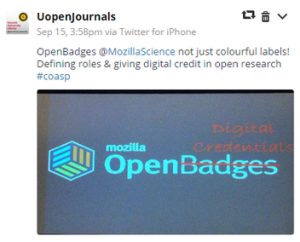
5. DOI Event Tracker (DET)
(Geoffrey Bilder – CrossRef – Geoffrey’s talk)
We assume you all know about DOIs (Digital Object Identifiers). The key element of this DOI is of course durable findability on the web. So, if you are able to find your publication everywhere, wouldn’t it be fascinating to see where it has been and what has been happening to it? That is exactly the question CrossRef is going to answer with their DOI Event Tracker. The release of this project is in 2016 and we are very curious to see how CrossRef aims to pass on useful data to the ‘object owner’.
While these top 5 initiatives have impressed us the most, you also should check out these other…
6. Products & Services in the making
- The Gates Foundation installed a new open access policy in January 2015 and demands all their publications will meet these open access terms in 2017. Researchers can adapt by using the new full-service platform CHRONOS that is being built to support them and track all peer reviewed research!
(Jennifer Hansen – Gates Foundation – Slides)
- Creative Commons is developing a new mobile app for CC-by images. We will be delighted to ‘give and take’ photos when the app is ready.
(Ryan Merkley – Creative Commons – Slides)
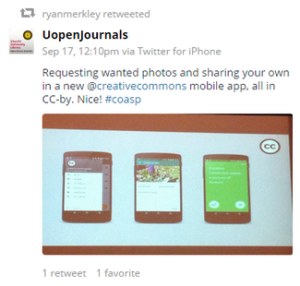
- ‘Think. Check. Submit.’ That’s what you should do when picking the best matching journal for your academic publication. (Can you also see the similarities with QOAM?)
(Lars Bjørnshauge/Caroline Sutton – Slides)
- ResearchPad is a cross-platform mobile app that aggregates and publishes open access articles from leading publishers in a readable format.
(Patrick Martinent – Newgen – Recording)
7. Big Discussion Points
- Marcus Munafo fueled a debate about how the scientific ecosystem is sometimes flawed and research reproducibility is at risk due to questionable practices.
(Marcus Munafo – University of Bristol – Recording)
- Books are peer reviewed too! During the session a few people were still under the impression that books are not peer reviewed the same way as articles. This is of course not true. University presses and commercial publishers often have a formal and rigid peer review procedure for all their book projects. There are also movements that advocate for full transparency in the review process. It is for instance mandatory to publish a press’ review procedure on the OAPEN platform.
- The negotiations between Dutch universities and commercial publishers on open access to articles got pushed into the spotlight as well. For the latest updates you can visit the VSNU website.
8. Inspiring and Debatable Innovations
- In an early career academic’s perspective the (first) academic publication, and therefore ‘the making or breaking of their career’, is in the hands of only 2 reviewers! Innovations are needed for better evaluation.
(Derek Groen – University College London – Slides)
(Moqi Xu – London School of Economics – Slides)
- Jonathan Gray not only talked about our collective responsibility to develop the future and support credible, useful and transparent research, he also used (and is still using) digital methods to analyze the academic open access market with data from twitter and other social media.
(Jonathan Gray – Open Knowledge – Recording)

- Pierre Mounier presented OPERAS. This project aims at a new infrastructure in Europe (for AHSS) to support the development of open access publishing in the humanities and social sciences. As mentioned on their website, the infrastructure will provide new approaches to impact and measurement of academic merit in regard to HSS research.
(Pierre Mounier – OpenEdition – Recording)
- Open Book Publishers is a scholarly led press that has found a way to keep publishing costs as low as possible by adopting a Freemium Business Model. Rupert Gatti presented the story behind OBP and pointed out why we need open access for scholarly monographs.
(Rupert Gatti – Open Book Publishers – Recording)
9. Familiar topics in a new perspective
- Publons openly rewards reviewers and helps improve the quality of the complete peer review process. They themselves are rewarded with 45k+ reviewers in total and 4k+ new reviews every week. (Andrew Preston – Publons – Slides)
- Creative Commons not only surprised us with a new app but also with Ryan Merkley who was just full of inspiration and wise words!
(Ryan Merkley – Creative Commons – Recording)

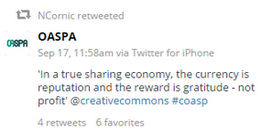
- Another inspirational boost came from Stephen Curry. He argued that research evaluation is ‘more than just an impact factor’ and that ‘metrics are indicators, not proxies’!
(Stephen Curry – Imperial College London – Recording)
- XML files are the foundation of your HTML articles. So Kaveh reminded us of the do’s and don’ts in your XML in the JATS4R format.
(Kaveh Bazargan – Representing a publisher collaboration – Recording)
- Did you know the field of anthropology is now also riding the open access wave? The Open Anthropology Library is one of the leading initiatives.
(Jenna Makowski – Alexander Street Press – Recording)
- And have you already heard about SCOAP3 and their open access publications in particle physics? Worth taking a look if you’re interested in the discipline.
(Salvatore Mele – CERN – Recording)
10. Initiatives on a national (and market) level
- In the Netherlands they are trying to boost the open access movement on different levels by collaborating with various stakeholders and setting national standards.
(Ron Dekker – Director Institutes NWO, Project leader Open Access NL – Slides)
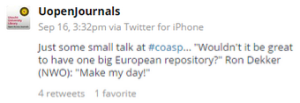
- In the United Kingdom they recently ran a large investigation on the transition to open access. Stephen Pinfield presented the results at COASP.
(Stephen Pinfield – University of Sheffield – Recording)
- In Norway the Arctic University (UiT) is one of the main stakeholders that is building further on the fundamentals of the green and gold road to open access.
(Jan Erik Frantsvåg – UiT The Arctic University of Norway – Recording)
- In Goettingen (Germany) open access is a high priority in the academic publishing scene and is therefore supported with central funds.
(Margo Bargheer – University Press Goettingen – Recording)
- In the Commercial Publishing Market the offsetting models are ‘talk of the town’.
Different presses and publishing venues presented their models to us at COASP:
‘IOPP and offsetting’ (Steve Hall – IOP Publishing – Recording)
‘Springer’s high-impact offsetting model’ (Juliane Ritt – Springer Nature – Slides)
‘Managing the total costs of publication’ (Liam Earney – Jisc Collections – Recording)
We know this is a lot of information for one blog! So just choose your favorite subjects and dig in deeper using the presentations published on the OASPA website. And last but not least you can have a look at the Uopen Journals poster we presented at the conference, explaining what we do as a publishing service.
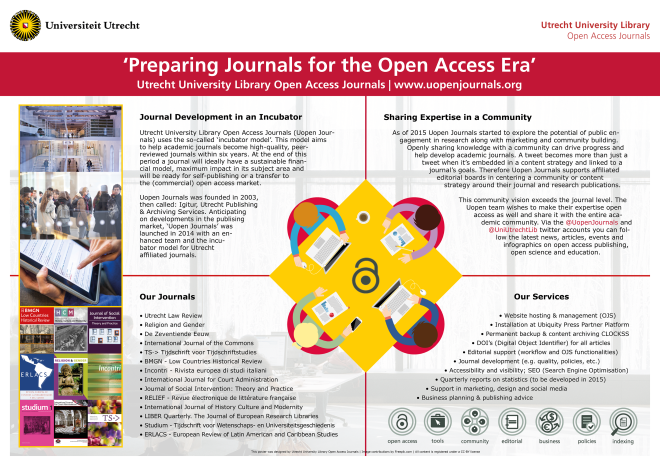
Written by:
Mare Derks (Online Marketer) & Jeroen Sondervan (Publishing Consultant)
Utrecht University Library Open Access Journals


Geef een reactie